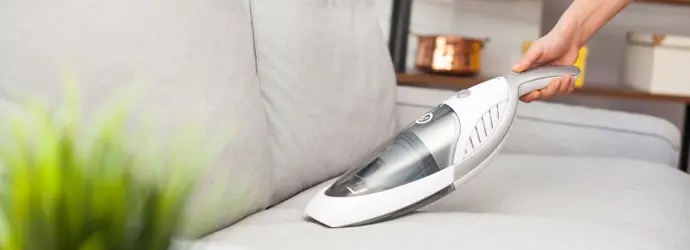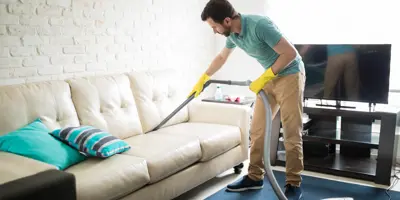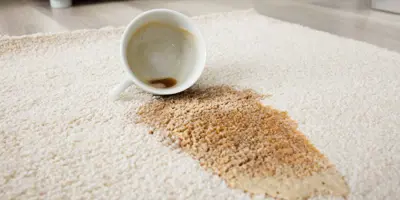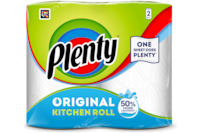1 person found this helpful

Adverts on TV always show someone dabbing up a tiny bit of Bolognese sauce or a single droplet of juice from their sofa.
But we all know that when something gets spilled on the sofa, it’s usually the whole bowl that slops onto a cushion or bottle that glugs out onto the fabric – that’s not how date night was meant to go, but oh well!
So, if you’re cleaning a sofa, you’re going to need a solid guide. We’ve got you covered; here’s how to clean a sofa.
1. Check the fabric type
First thing when cleaning a sofa, is to check what type of material you’re dealing with. Some sofas have covers you can remove and throw in the washing machine. If that’s yours, you’re sorted! Just follow the instructions and voilà. If that’s not you, it’s still fine – there should be a label somewhere on the upholstery that tells you what type of fabric it’s covered in. These codes will tell you the best way to clean your sofa:
- WS – Can be cleaned with a steam cleaner or dry-cleaning detergent
- S – Can only be cleaned with dry-cleaning detergent
- W – Can be cleaned with water or steam
- X – Can be cleaned with a vacuum only; no fluids.
2. Gather your tools
Keeping a sofa cleaning solution in the back of your cupboard is always a good idea if there’s a saucy mishap. The manufacturer of your couch might recommend a specific brand. Alternatively, you can buy one in most supermarkets and hardware stores, or even make your own using three parts water to one part white vinegar.
Once you’ve found a sofa cleaning solution that’s right for your upholstery, remember to patch-test it on an invisible area before you use it on the whole sofa – accidentally bleaching your furniture makes a great story, but it might not match the interior design you’ve got going on in the rest of the room.
3. Act fast when cleaning a sofa
The first step in sorting sofa stains is to soak up any liquid straight away. Take a strong and absorbent kitchen towel, such as Plenty, and lay it gently over the stain until any liquid has completely soaked in. Try not to dab or rub it because this could work the stain into the fabric and make sofa cleaning more difficult later.
Cleaning sofa cushions is easiest when the stain is still a little bit wet, but not so wet that it’s likely to spread. So it’s best to sort the mess out (so, for example, scoop the spaghetti off the sofa and focus on the sauce – that’s the bit that’ll stain).
Tip
Keep Plenty Towels near to hand, so you can grab a piece and mop up your sofa spillage in record time.
4. Raid your cupboards
If you skipped Step 2, all is not lost. Here are some classic types of spills and stains, and how to clean a sofa once they’ve happened, using things you’ll probably find in your kitchen cupboard. Just don’t forget to test whichever cleaning method you go for on a small hidden area before you dive in.
- Grease – Once you’ve soaked up the excess, cover the area with baking soda and leave it to absorb the grease for an hour or so. After that, vacuum the powder away.
- Ink – Moisten a piece of kitchen towel with some white spirit and use it to dab the stain until it disappears. Plenty household towels are ideal here, because it will hold together for blotting and even scrubbing.
- Red wine – As with grease, cover the area with baking soda or cooking salt and leave it to absorb for an hour or so, then vacuum.
- Tomato – Mix one tablespoon of dishwashing soap into 500 ml of cold water, then use a piece of kitchen paper to sponge it onto the stain.
5. Rinse and dry
You should always follow the instructions on the packaging if you’re using a commercial cleaning solution. But if you’ve used one of the home remedies in Step 4, you’ll need to blot the area again with a piece of kitchen towel and some water to make sure nothing’s soaking into your upholstery that could potentially fade the fabric.
After cleaning a sofa, it’s best to let it dry thoroughly before you start using it normally again: wet fabric attracts dust and grime, so you could find that the stain gets replaced with an unsightly grey patch – and even if you’ve got a grey sofa, it’s still best to let it dry.
6. Relax!
And remember, everyone makes a mess, and everyone has an old stain on their sofa that they place a throw cushion over to hide it. But now that the whole house has these instructions, you can be all-hands-on-deck when that fried-egg sandwich spurts yoke all over the sofa.
Related articles
How to clean a well-loved leather sofa
Want to know how to clean leather sofa? Whether it’s a cushion corner or a full suite, click to find out the best way to clean a leather sofa.

Easy tips for removing chewing gum from carpet and sofas
Removing chewing gum from carpets or upholstery is easy once you know what to do. View our simple guide on how to get gum out of a carpet or sofa.

How to remove chocolate stains on carpets and upholstery
Chocolate stained carpets are easier to deal with than you think! Click here for advice on how to remove chocolate stains quickly and easily.

How to Remove Wax from the Carpet or Sofa
Spilled candle wax on your spotless sofa or carpet? Learn how to remove wax from carpets quickly and easily with these tips from Plenty.

Coffee-stained carpet? Cleaning ideas to try
There’s no getting away from it — accidents like spilt coffee on carpet floors are a fact of life. This guide shows you how to get coffee out of carpet.

How to clean the carpet: 3 handy-to-know tips
It’s always good to know how to clean carpet stains by hand. Click here for the best way to spot clean a carpet along with more carpet cleaning tips.



